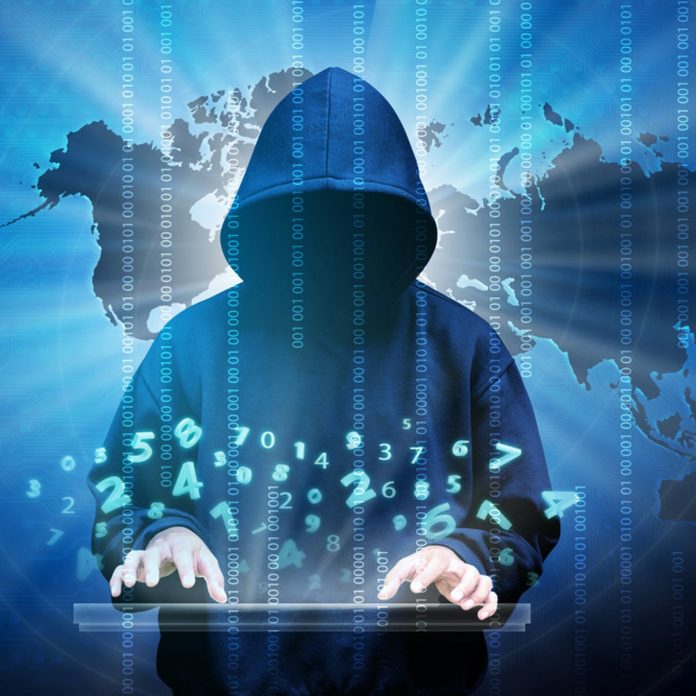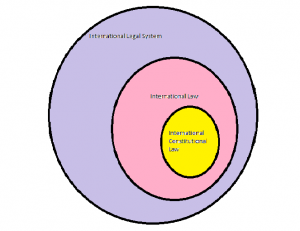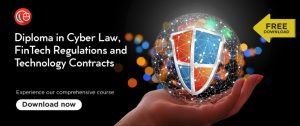
This article has been written by Saswati Soumya pursuing a Diploma in Cyber Law, FinTech Regulations, and Technology Contracts from LawSikho.
Table of Contents
Introduction
As per Philip Allott in “The concept of International Law”, international law is a subset of the international legal system. An international legal system is essentially the integration of all subordinate legal systems, i.e., international constitutional law.

To understand the meaning of international constitutional law, let us take the example of the League of Nations. It is an international diplomatic group that was developed after World War I so that disputes between countries can be solved before they resort to open warfare. It is often critiqued that this international diplomatic group puts its own self-interest before centering its focus on conflict resolution. At the same time, this international diplomatic group contends that individual governments that are a part of this group do not recognize its authority. Eventually, this international diplomatic group ceased its operations during World War II. From a legal perspective, the main legal instrument that was responsible for the formation of this international diplomatic group is the Treaty of Versailles.
Oftentimes, ideas of peace and conflict resolution are translated into the paper by virtue of a legal instrument. Otherwise, the idea merely becomes a figment of imagination. It is important to note that, from an international politics perspective, the formulation of this treaty and the subsequent formation of the League of Nations had a direct impact on the autonomy of the United States in international matters. In this case, all the member states have their own set of laws. At a macro level, every member state has a unique society, that is a culmination of different ethnicities. For instance, the choice of music might vary from classical to Carnatic from region to region. The society which listens to classical music on Spotify and YouTube is a separate state society from the sect of society that listens to rock music on Soundcloud. To give you another example, the geographical conditions in one part of the society might be very different from the urban realities of another part of the society.
Even though sub-societies are fragmented, such societies are not deprived of expressing their uniqueness. For instance, the Netherlands which is a constitutional monarchy is different from India, which is a parliamentary democracy. But, both these countries have the imperative duty to care for the digital freedoms of their citizens via freedoms that are guaranteed expressly in their constitutions.
Issues concerned
Daniel Joyce in “Internet Freedom and Human Rights” argues that human rights protection is required beyond freedom of expression and raises the question if internet freedom should be configured as a human right or not. They argue that internet freedom has to be weighed from the perspective of “right to communicate” along with freedom of expression, in a system of international communication that eventually forms an information society that is integrated. This is because;
- changes in communication technologies via satellite communications required that a new human right to communicate is required to be introduced in addition to Article 19 of the Universal Declaration of Human Rights (“UDHR”);
- The Human Rights Committee argues that the term “expression” also includes the right of access to information since this involves the act of giving and receiving. It is the prerogative of the state parties to ensure that the individuals have this right in the context of accessing digital media
The author argues that freedom of expression is traditionally founded on the right to free speech. This right recognizes that there is a need for political communication between citizens and the government that is free of hindrances so that they can ramp up their efforts to not only participate in the government but also to form the government so that society is developed. The author argues that the legal instrument that recognizes this idea is Article 19 of the UDHR imbibes an idea of freedom of expression that is neither concerned with an old media or a new media, but concerns “any media and regardless of frontiers” encompassing (1) right to express oneself; and (2) right to seek and receive information. From a practical perspective, the main challenge associated with the implementation of this idea is the inequality and inequity prevalent in accessing “media, information and communications infrastructure” that also includes the challenge of access to;
(1) information and communication technology from a software perspective; and
(2) access to hardware such as inexpensive laptops, mobile phones, and smartphones, i.e., “digital divide”.
Consequence and effects
This problem eventually led to the formation of a broker that would liaison between the private sector interests and the broader interests of the member states. For instance, the Internet Corporation for Assigned Names and Numbers (“ICANN”) was formed so that it can facilitate public governance of the internet. It would not be wrong to argue that the US gained back its autonomy via playing a key role that it had lost during World War I because it was responsible for governing “domain names”. The US retained control over essential internet infrastructure by stationing the root servers in US soil & created an Internet Governance Forum in order to enable civil society participation in the times to come. From a public policy consultant’s perspective, one is required to identify the difference between soft law and hard law. The aforesaid paragraphs illustrate the aspects of soft law and not hard law.
For understanding hard law, reference is made to precedents that have already been established and dealt with in the past. As per Hillary Clinton, the then Secretary of State iterated the concept of internet freedom from Roosevelt’s four freedoms of speech that includes;
- old freedoms like speech and religion; and
- new freedoms like freedom to connect online that are coupled with “on the ground” effects of such online connections via communication networks
These effects are felt only in situations that cannot work without the cooperation of human beings, i.e, a response mechanism for raising funds for humanitarian purposes. It is also argued that the on-ground realities of society also get reflected in the darker sides of the internet via attacks on networks by cybercriminals.
From an individual perspective, the limits of free expression are found in terms of terror speech, hate speech, anonymity, privacy, and intellectual property theft. Putting the cap of a liberty believer, the anonymity of individuals can be used as a means for the protection of human rights via using online tools such as onion router (“TOR”) to cover their tracks and avoid government control. From a soft law perspective, the central argument is focused on forms of “norms of behavior”, that can be challenged by lack of empathy and identifying the exact communities that are concerned with establishing a legal order that is universal. It is argued that, from a regulatory perspective, it is imperative for the regulator to apply the principles of proportionality and necessity while deciding on the contentious issues and non-contentious issues associated with digital freedom. The assessment must start with understanding the meaning of “access”.
Does the matter in hand refer to access or denial of access to infrastructure or content?
On another note, it is ironic that Paul M. Secunda, the author of the article titled “The employee right to disconnect” wrote this article not only during vacations but also after normal working hours. Paul argues that digitization has made it difficult for employees in the US to escape work that has, in turn, raised questions surrounding “privacy at the workplace” and “autonomy of employees”. The author engages with the literature that argues that it would be wrong to undermine the reasons behind the enactment of legislation surrounding “maximum number of hours that one should work for”, “overtime” or “ weekend” that play a critical role in the advancement of industrial societies. The focus of work is always to provide “other utility-maximizing” goods to their respective families and friends in the form of “housing, food, recreation, retirement, vacations, and entertainment”.
It is important to note that there is a difference between the ways in which countries with civil law origin regulate this issue from the way in which countries with common law origin regulate the same issue. Before that, I want to clarify that the legal system of;
(1) Canada is a mix of common law and civil law;
(2) the United States is common law; and
(3) France and Germany are civil law.
There was an absence of any specific law on the issue of “whether or not the employees have a right to be free from electronic workplace communication once their day ends”? As of 2019, there was no specific law that governed this practice in the US and Canada. At the same time, as of 2019, the applicable law in France is called “Droit a la de connexion” and the prevalent practice in Germany is similar to, and not the same as, corporate self-regulation that is entirely voluntary as opposed to being mandatory. It would not be wrong to state that this form of regulation promotes a human rights protection framework that is built on the “laissez-faire” approach to the relationship between the employer and the employee. The emergence of remote work culture has resulted in outsourcing the work to resources in Indonesia and the United States. For the purpose of this article, I shall explain the labor law associated with remote work that is associated with cyberspace.
The US and the applicable law
In the US, the applicable law is the Occupational Safety and Health Act (“OSHA”) which bifurcates employees into
(1) exempt employees; and
(2) non-exempt employees
Exempt employees are those employees who cannot earn even if they work overtime. On the other hand, non-exempt employees are those employees who can earn overtime. Overtime has defined as the extra number of hours that one works beyond the stipulated work hours. The extra number of hours could be up to 40 hours in a week. From an adjudicator’s perspective, such issues have to be looked at from the lens of safety and health of the employees and separated from the issues of privacy, autonomy, productivity, and leisure. This is because there is a horizontal relationship between the former issues and the later issues.
In simpler terms, more time spent with oneself increases the well-being of an individual keeping all the later issues in tandem with each other. The author also engages with the literature that argues that products of technological convergence such as e-mails and video conferencing calls have weakened the boundary between work life and home life, which eventually piles up and makes one feel that there is a burnout that has resulted from stress and anxiety. This is the reason behind arguing for the right to disconnect, especially by escaping from emerging technologies like microchipping.
In my opinion, microchipping is in fact an extreme side of cyborg innovation thereby giving new meaning to body modification practices that are already prevalent in the form of body art. The lesser extreme approaches that are currently being employed by employers, especially multi-national organizations, are the workplace wellness programs.
These programs have blurred the line between work life and family life because the employers always have an intimate data profile of their employees, i.e, surveillance. Oftentimes, because of power asymmetry, employees tend to feel coerced to submit to the wills and wishes of the employers. It is called coercion because the legitimate business interests of the employer coincide and conflict with the “protected interests in personal autonomy” of the employees that lie outside of the strict workplace.
Personal autonomy and its traits
The characteristics of personal autonomy of an employee are as follows:
(1) ensuring that its conduct that lies outside of the work that may or may not flow from the employer-employee relationship is lawful;
(2) inculcating beliefs outside of work, that can include political, moral, ethical, religious, or other personal beliefs;
(3) belonging to associations and assemblies that are lawful
Such characteristics have to be borne in mind by the freelancing websites which hire freelancers from another country to provide service in a completely different country.
The rule and its applicability
In the Netherlands, digital freedom is protected in the form of freedom of expression that is guaranteed to all the citizens under Article 7 of the Dutch Constitution and Article 10 of the European Convention on Human Rights (“ECHR”). In such a case, it is argued that the ECHR acts as an international constitutional legal instrument that shadows the constitutional provisions in the Netherlands. Article 7 of the Dutch Constitution reads as follows;
“(1) No one shall require prior permission to publish thoughts or opinions through the press, without prejudice to the responsibility of every person under the law.
(2) Rules concerning radio and television shall be laid down by the Act of Parliament. There shall be no prior supervision of the content of a radio or television broadcast.
(3) No one shall be required to submit thoughts or opinions for prior approval in order to disseminate them by means other than those mentioned in the preceding paragraphs, without prejudice to the responsibility of every person under the law. The holding of performances open to persons younger than sixteen years of age may be regulated by the Act of Parliament in order to protect good morals.
(4) The preceding paragraphs do not apply to commercial advertising.
Article 10 of the ECHR states that,
(1) Everyone has the right to freedom of expression. This right shall include freedom to hold opinions and to receive and impart information and ideas without interference by public authority and regardless of frontiers. This Article shall not prevent States from requiring the licensing of broadcasting, television, or cinema enterprises.
(2) The exercise of these freedoms, since it carries with it duties and responsibilities, may be subject to such formalities, conditions, restrictions, or penalties as are prescribed by law and are necessary for a democratic society, in the interests of national security, territorial integrity or public safety, for the prevention of disorder or crime, for the protection of health or morals, for the protection of the reputation or rights of others, for preventing the disclosure of information received in confidence, or for maintaining the authority and impartiality of the judiciary.”
As a matter of rule, it is advisable not to reproduce the provisions of a foreign statute. However, for the purpose of this article, it was necessary to do the same because the reading of the constitutional provision throws light on the freedoms of citizens that continue to be guaranteed in cyberspace as well.
Analysis
In the context of the current health crisis, e-healthcare services have become important. E-healthcare service is defined as the usage of digital technologies and telecommunications, such as using computers to facilitate health care services. It is to be noted that e-health has to be bundled with the traditional non-digital approaches for delivering information to the patient. The e-health literature identifies multiple themes like,
(1) networked care;
(2) inter-jurisdictional practice;
(3) diffusion of e-health with digital divide;
(4) e-health integration with existing systems;
(5) response to new initiatives;
(6) goal-setting for health policy;
(7) evaluation and research;
(8) investment, and
(9) ethics in e-health
All these themes have a global element attached to them. In simple terms, it means that, if one were to look at these themes from space, then the theme of inter-jurisdictional care will be the most relevant from an international health lawyer’s perspective. This concept of “inter-jurisdictional care” can be applied to ensuring the safety of citizens in the offline world as well in the context of adding meat to the idea of vaccine passports. A vaccine passport is proof that one has tested negative and shows that they have been protected against infections that concern public health. The idea behind the vaccine passport is that it is a digital substitute to the yellow card that was earlier called the International Certificate of Vaccination. This certificate is a booklet approved by the World Health Organization (“WHO”) that documents one’s past inoculations. In layperson’s terms, this refers to the process of artificially creating antibodies. Technology is the digital health record of an individual.
It is argued that the concept of inter-jurisdictional care can be applied to overcome the problem of different requirements of the nation-states on vaccination regulation. From a regulatory perspective, this could combat the issue of counterfeit versions of the yellow card, thereby leading to a much more secure record. In the times to come, there might be a possibility to link such results to the boarding pass, so that the dispute of aisle seats and window seats can be resolved. The advantage of implementing this proposal is that international travelers will have peace of mind that they are amongst immunized people, especially in a crowded place like a crowded concert or a cricket stadium. The downside of using this technology is that people who do not have access to a smartphone would not be able to enter such public places. This in turn shall affect their public life and their private life, which are the two pillars of the right to privacy.
Conclusion
To conclude, the internet as infrastructure has become a part of the message that is communicated by the sender to the receiver, as opposed to merely being the medium. This analogy can be applied to the digital health record, which would use the internet as a medium to communicate the details of a layperson who is traveling from the North Pole to the South Pole to the base camps that are situated on both ends of this world on a real-time basis. If both the base camps can create an integrated database and store the same in the cloud, then it shall be less cumbersome for the aviation authorities to double-check their health status. In my opinion, the implementation of a vaccine passport can give more control to a traveler because they would be aware of their health before traveling. Earlier, the medical tests were not necessarily at the disposal of the traveler, which brought immense travel anxiety.
References
- Philip Allott, “The concept of international law”, EJIL, 1999. Accessible at <http://www.ejil.org/pdfs/10/1/577.pdf >
- Iain Marlow and Jason Gale, “Vaccine passports for international travel: What’s the idea behind it?”, The Mint, February 11, 2021. Accessible at <https://www.livemint.com/news/world/vaccine-passports-for-international-travel-what-s-the-idea-behind-it-11613017512378.html >
- Shariq Khoja, Hammad Durrani, Parvez Nayani, and Ammad Fahim, “Scope of policy issues in eHealth: Results from a structured literature review”, Vol 14, No 1 (2012): Jan – Feb. Published on February 17, 2012. Accessible at < https://www.jmir.org/2012/1/e34/ >
- WebMD Medical Reference, “What is a vaccine passport?”, Reviewed by Brunilda Nazario, MD, March 11, 2021.
- Oscar Schwartz, “The rise of microchipping: are we ready for technology to get under the skin ?”, November 8, 2019. Accessible at <https://www.theguardian.com/technology/2019/nov/08/the-rise-of-microchipping-are-we-ready-for-technology-to-get-under-the-skin >
- Daniel Joyce, “Internet Freedom and Human Rights”, European Journal of International Law, Volume 26, Issue 2, May 2015, Pages 493-514, Published on September 4, 2015. Accessible via <https://academic.oup.com/ejil/article/26/2/493/423010>
- Secunda, Paul M. (2019), “The Employee Right to Disconnect”, Notre Dame Journal of International & Comparative Law, Volume 9: Issue 1, Article 3. Accessible at < https://scholarship.law.nd.edu/ndjicl/vol9/iss1/3/ >
- History.com, “League of Nations”, Original Article was published on October 12, 2017. This article was later updated on March 5, 2020. Accessible on < https://www.history.com/topics/world-war-i/league-of-nations >
Students of Lawsikho courses regularly produce writing assignments and work on practical exercises as a part of their coursework and develop themselves in real-life practical skills.
LawSikho has created a telegram group for exchanging legal knowledge, referrals, and various opportunities. You can click on this link and join:
 Serato DJ Crack 2025Serato DJ PRO Crack
Serato DJ Crack 2025Serato DJ PRO Crack









 Allow notifications
Allow notifications



